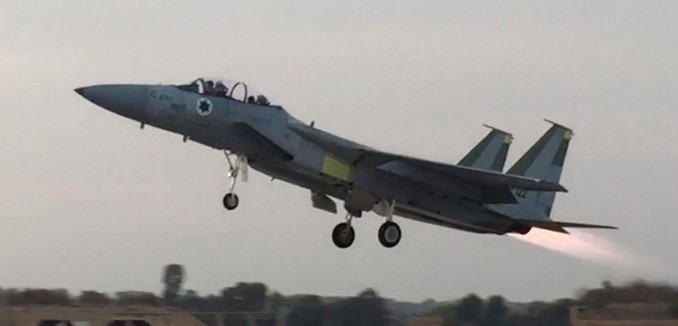When Israeli engineers at the Israeli Air Force’s (IAF) Depot 22 asked Boeing, the prime contractor for an F-15B that had been severely damaged, if it could rehabilitate the plane by attaching its undamaged front section with the rear section of another damaged plane, Boeing never returned the call.
According to Lt. Col. Maxim Orgad, the commander of Depot 22’s Engineering Division, Boeing didn’t acknowledge the request because “they thought we were joking,” Defense News reported Monday in an account of how the depot salvaged a plane that was thought to be a total loss.
Six years prior, the F-15B Arrowhead caught fire after a flock of pelicans was sucked into its engines. The pilot and navigator managed to land the plane, but the entire rear end was burnt. After years of debating what to do with the damaged aircraft, engineers at Depot 22 suggested grafting the front end of the F-15B onto the back end of an obsolete single-seater F-15.
According to Orgad, the total cost of rehabilitating the plane was less than $1 million. In contrast, “today, to buy an aircraft like this would cost more than $40 million,” he observed.
“I don’t know of any other air force that works to revive aircrafts that others would throw away or, at best, disassemble for parts. But for us, this is our mission. We can’t afford otherwise,” Orgad explained.
Boeing praised the efforts of Depot 22 and said, “We very much appreciate the professionalism and capabilities of this unit, and, at times, we have also learned from it for mutual benefit.”
Orgad told of another case where Depot 22 demonstrated its inventiveness, in 2014, just before Israel’s war against Hamas, Operation Protective Edge, when Lockheed issued a warning about cracks in the bulkheads in its F-16.
“Lockheed put out safety bulletins about the cracks, and said that in order to check to see if there are cracks, we should remove all the fuel in the system first. That would take about a month per plane; and if we had to check all the aircraft, it would have taken years,” Orgad recalled.
Instead Depot 22 developed an ultrasonic device that could determine which planes had the cracks and how badly damaged they were. This approach allowed the IAF to test all the affected aircraft in less than three weeks.
Subsequently, Lockheed sent another notice warning that any plane that had a crack larger than eight millimeters should have the bulkhead replaced, a process that could take up to 18 months.
Instead of the manufacturer’s recommended procedure, Lt. Col. Haim Mirngoff, Depot 22’s aircraft engineering branch commander, devised a repair.
“At first, the manufacturer told us it couldn’t be repaired,” Orgad said. “But Haim’s repair not only works, it can be be implemented at the base. No need to bring aircraft here for depot level.”
When Israeli Air Force Commander Maj. Gen. Amir Eshel checked out the base where the squadron was housed, he found that it had a 100% readiness rate for its aircraft. Eshal praised Depot 22 for its independent maintenance capabilities.
“If our unit had to wait for the manufacturer to develop a repair, that squadron might have missed the war,” Orgad said.
[Photo: י. א. פליישר / WikiCommons ]




